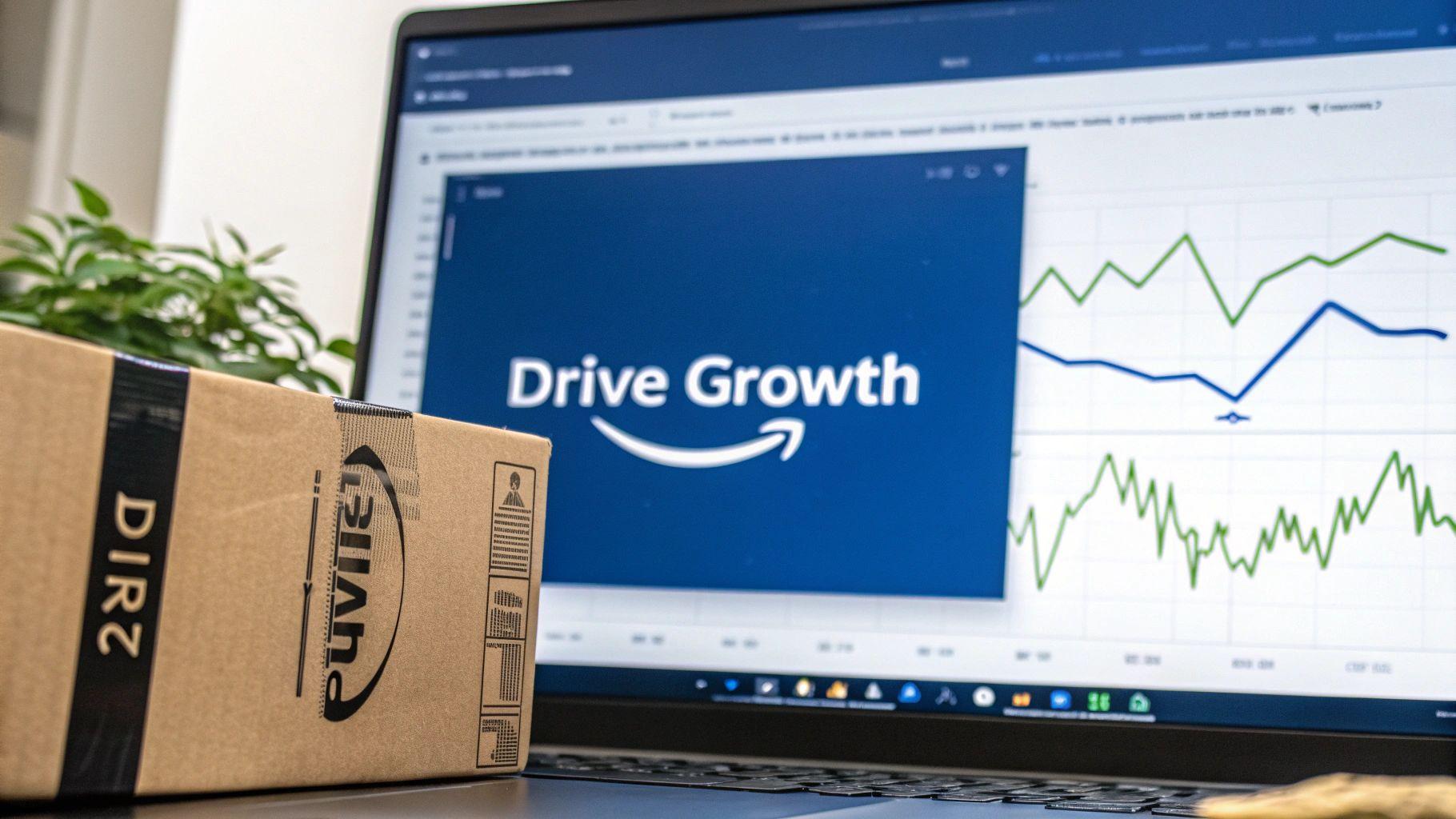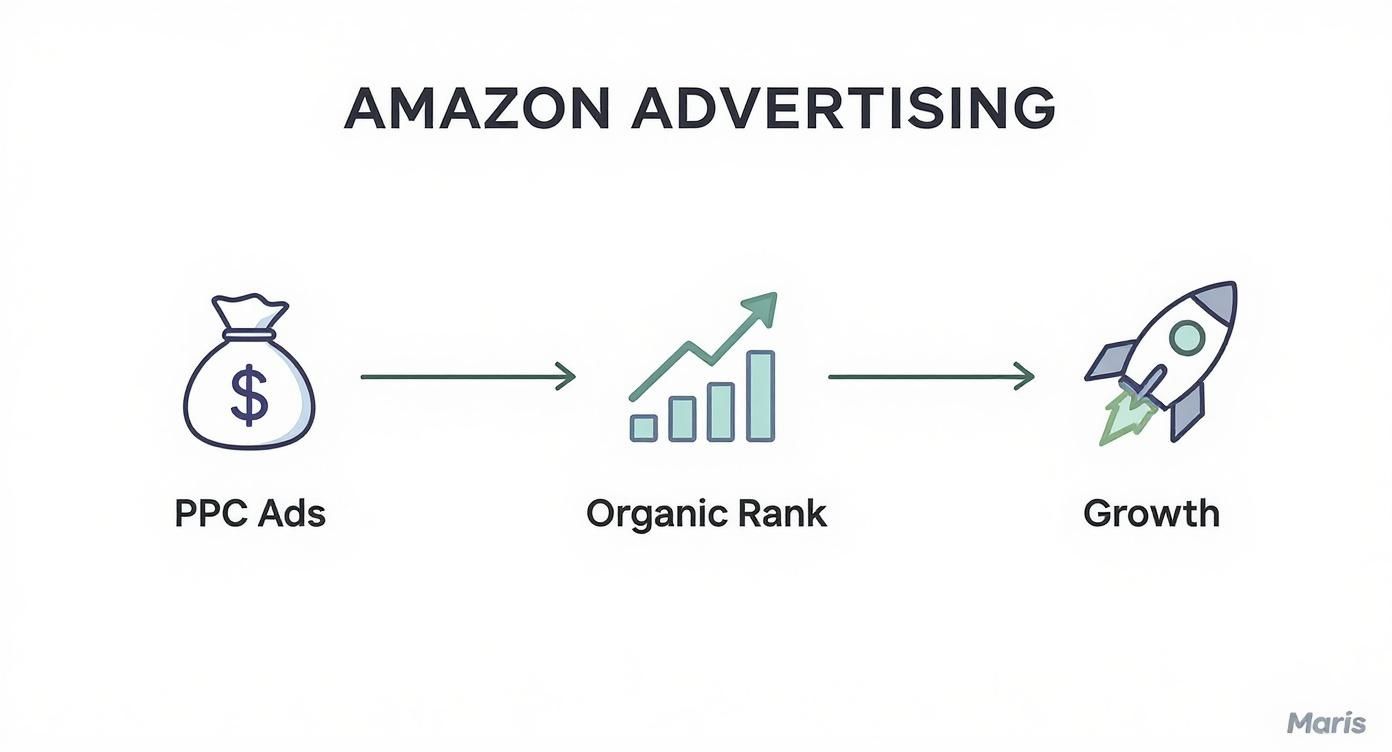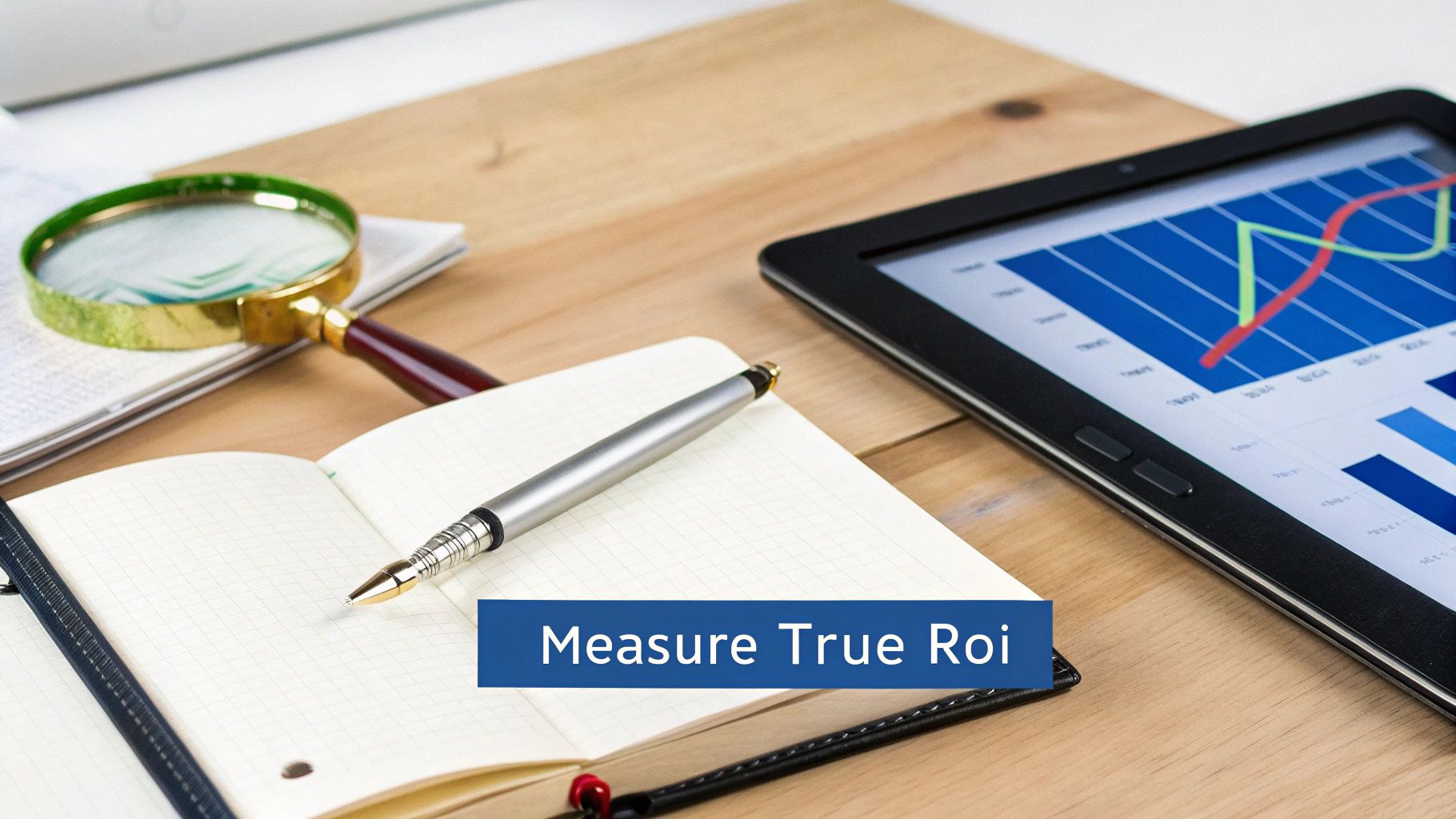Amazon Advertising Management Services: The Performance-First Guide
Discover how top-tier Amazon advertising management services drive sales, boost organic rank, and improve profitability with performance-first strategies.

Think of Amazon advertising management services as a strategic partnership designed to drive profitable growth, not just manage bids. It's about connecting every ad dollar to a clear business outcome—igniting organic sales, capturing market share, and building a sustainable competitive advantage. It's the difference between treating advertising as a cost center and leveraging it as your primary growth engine.
Why Bids and Budgets Are Only Half the Story
For many eCommerce leaders, Amazon advertising is a necessary evil—a cost of doing business just to be seen. This defensive mindset leads to budget-first decisions that stifle growth. The alternative? View advertising as a strategic investment—the most powerful lever for driving the Amazon flywheel and achieving sustainable scale. This is the core philosophy of high-performance Amazon advertising management services.
The objective isn't just a low Advertising Cost of Sale (ACoS). The real goal is to use paid placements to generate sales velocity, which signals to Amazon's A9 algorithm that your product is a winner. This boosts your organic ranking, which drives more sales, which further improves your rank. It's a self-perpetuating cycle that allows brands to dominate their categories.
Shifting from Cost Center to Growth Engine
When advertising is viewed as an expense, decisions are reactive. When viewed as a growth driver, every campaign becomes a strategic investment aimed at a specific business goal. Making this shift requires a partner who understands the deep, symbiotic relationship between paid media and the overall health of your brand on the marketplace.
This performance-first approach hinges on a few key principles:
- Connecting PPC to Organic Growth: Using the sales velocity from paid ads to systematically improve organic search rankings for high-value keywords.
- Focusing on True Profitability: Moving beyond ACoS to measure Total Advertising Cost of Sale (TACOS), which reveals the impact of ad spend on total business revenue.
- Strategic Market Share Capture: Deploying both offensive and defensive campaigns to protect your brand's digital shelf while actively seizing territory from competitors.
The right advertising strategy doesn't just find customers; it creates a competitive moat. By using paid ads to fuel the organic sales algorithm, you make it progressively harder for competitors to unseat you.
This strategic pivot is more critical than ever. Amazon's ad business is a juggernaut, pulling in $15.69 billion in Q2 2025 alone—a 23% year-over-year increase. With ad placements expanding across platforms like Prime Video, the marketplace is only getting more competitive. You can dig deeper into Amazon's advertising growth on Nasdaq.com. Expert management ensures every ad dollar serves a clear business purpose, transforming your budget from a line item into a powerful tool for scalable growth.
The Pillars of High-Performance Ad Management
Top-tier Amazon advertising management is a system, not a series of disconnected campaigns. True performance stems from a cohesive strategy where every component works in concert to drive business-level results. This moves far beyond simple bid adjustments and into the realm of building a durable growth engine for your brand.
It starts with a fundamental mindset shift: ads are not just for immediate sales. They are your primary tool for influencing Amazon's algorithm, building brand equity, and carving out defensible market share. A winning strategy is built on four core pillars that work together to drive profitability and scale.
Full-Funnel Strategy Development
First, any service worth its fee will develop a full-funnel advertising strategy. This isn't about mindlessly targeting bottom-funnel "buy now" keywords. It’s about architecting a customer journey, using specific ad types to guide shoppers from initial awareness to loyal, repeat purchasers.
This requires deploying different ad types for specific objectives:
- Top of Funnel (Awareness): Using Sponsored Brands and Sponsored Display to introduce your products to new audiences who aren't yet searching for you by name. This is about making a calculated first impression.
- Middle of Funnel (Consideration): Re-engaging shoppers who have shown interest but haven't purchased. Retargeting campaigns keep your brand top-of-mind as they evaluate their options.
- Bottom of Funnel (Conversion): Aggressively targeting high-intent keywords with Sponsored Products to close the sale and defend your digital shelf space from competitors trying to poach your traffic.
Data-Driven Optimization and the Flywheel
The second pillar is a ruthless commitment to data-driven optimization. This is the operational engine of any successful ad program. It involves using real-time performance data to continuously refine bids, targeting, and creative, making thousands of micro-adjustments that compound into significant gains.
But the goal isn't just a lower ACoS. The real prize is igniting the PPC-to-organic flywheel.
This diagram illustrates how strategic ad spend directly fuels your organic rank, creating a powerful, self-sustaining growth cycle.

Every sale generated by a paid ad sends a positive signal to Amazon's A9 algorithm. Amazon recognizes this sales velocity, rewards your product with improved organic visibility, and that visibility leads to more sales—a virtuous loop.
The ultimate goal of PPC is to make itself less necessary over time. By driving sales velocity, you improve organic rank, which generates "free" sales, reducing your long-term reliance on paid traffic for core keywords.
Profitability and the Big Picture
Finally, the most critical pillar: a relentless focus on profitability analysis. An expert partner looks past vanity metrics like ACoS to understand how campaigns truly impact your bottom line.
This means measuring Total Advertising Cost of Sale (TACOS). This single metric reveals how ad spend lifts your entire business, not just ad-attributed sales. This holistic view ensures your ad budget is an investment—one directly tied to your brand’s growth and market dominance.
Comparing In-House vs Managed Amazon Ad Services
Deciding whether to build an in-house team or hire a specialized service is a classic "build vs. buy" scenario. The right choice depends on your resources, in-house expertise, and growth ambitions.
| Aspect | In-House Team | Managed Service |
|---|---|---|
| Resources & Cost | Requires salaries, benefits, training, and expensive software subscriptions. | A predictable monthly fee, often less than a single full-time hire. Access to top-tier tools included. |
| Expertise & Strategy | Expertise is limited to the knowledge of your team members. | Access to a team of specialists with cross-category experience and advanced strategies. |
| Time to Impact | A steep learning curve can mean slow initial progress and costly mistakes. | Can implement proven strategies and deliver results much faster. |
| Data & Technology | Relies on standard Amazon reports or requires investment in third-party tools. | Utilizes proprietary technology and advanced analytics for deeper insights. |
| Scalability | Scaling up or down requires hiring or layoffs, which is slow and disruptive. | Flexible and can easily scale services to match your growth or seasonal needs. |
An in-house team offers deep product knowledge and cultural alignment. However, a managed service provides a level of specialized expertise, technology, and strategic insight that is incredibly difficult—and expensive—to replicate internally.
How to Measure the True ROI of Your Ad Spend

For too long, eCommerce leaders were conditioned to obsess over one metric: ACoS (Advertising Cost of Sale). While useful, ACoS only measures the efficiency of your ads in generating ad-driven sales. It completely ignores the powerful halo effect advertising has on organic sales—the true engine of long-term, profitable growth.
Focusing solely on ACoS is like judging an iceberg by its tip. You're missing the massive, powerful foundation just below the surface. To understand the real performance of your advertising investment, you need a metric that reflects the health of your entire Amazon business, not just your PPC campaigns.
The Shift to Total Advertising Cost of Sale (TACOS)
This is precisely where TACOS, or Total Advertising Cost of Sale, becomes the critical KPI. The calculation is simple: (Total Ad Spend ÷ Total Revenue). It provides an unvarnished view of how efficiently your ad dollars are fueling overall business growth, including both paid and organic sales.
TACOS answers the most important question for any brand: "Is my advertising making my whole business more profitable and less dependent on paid ads over time?" When your TACOS is going down, it's a great sign that your flywheel is spinning—your ads are successfully boosting your organic sales.
A best-in-class amazon advertising management services partner builds their entire strategy around improving this metric. They understand that a campaign with a high ACoS might be a strategic win if it’s driving organic rank and sales for a crucial search term. For a deeper dive, check out our guide on how to calculate TACOS and why it matters.
A Practical Example of TACOS in Action
Imagine launching a new product with an aggressive ad campaign that yields a 45% ACoS. On the surface, that looks inefficient.
But let's examine the full impact:
- Week 1: You spend $2,000 on ads, generating $4,444 in ad-attributed sales (45% ACoS). Your organic sales are minimal at $1,000.
- Total Revenue: $5,444
- TACOS: 36.7% ($2,000 / $5,444)
- Week 8: After two months of sustained ad-driven sales, your organic rank has climbed significantly. You still spend $2,000 on ads, but organic sales have grown to $10,000.
- Total Revenue: $14,444
- TACOS: 13.8% ($2,000 / $14,444)
Suddenly, that "expensive" 45% ACoS campaign is revealed as a brilliant strategic investment. It kickstarted the organic flywheel, leading to a much healthier and more profitable business. This holistic view is increasingly vital as ad dollars flood the platform. Projections show Amazon's ad revenues will soar past $60 billion in 2025, driven by brands vying for purchase-ready shoppers. You can read more about Amazon's retail media growth on emarketer.com.
The takeaway is clear: stop managing your ads in an ACoS vacuum. Partner with an expert who measures success by the metric that actually reflects business growth—TACOS. It's the only way to treat ad spend as a strategic investment in your brand’s future.
Vetting Your Next Amazon Advertising Partner

Choosing an Amazon advertising management service isn't just hiring a vendor; it’s selecting a growth partner. This decision directly impacts your profitability, market share, and long-term brand equity. To make the right choice, you must cut through the sales pitches and scrutinize how potential partners think, operate, and measure success.
A competent partner will talk about growth. A great partner will show you their playbook. Their answers should be grounded in data, profitability, and a deep understanding of the Amazon flywheel. It's time to move beyond vague promises and ask the pointed questions that separate tactical executors from true strategic partners.
Key Questions to Ask Potential Partners
During your initial calls, drive the conversation toward strategy, process, and accountability. How they respond will reveal their true capabilities.
Here are the essential questions you should be asking:
- How do you measure success beyond ACoS? If they don't immediately pivot the conversation to TACOS (Total Advertising Cost of Sale) and its relationship to profitability, consider it a major red flag. A partner who can't articulate how their ad spend will lower your TACOS over time is operating in a silo, detached from your real business goals.
- Show me a case study where your advertising directly improved organic rank for a high-value keyword. This question cuts to the core of the PPC-to-organic flywheel. A sophisticated agency should be able to provide clear data showing how their ad strategy increased sales velocity, which in turn lifted a product's organic ranking for a valuable search term.
- What is your process for systematic testing and optimization? Any high-performance agency operates on a structured, continuous testing framework. They should be able to walk you through how they methodically test creative, bidding strategies, and targeting to maximize performance and uncover new opportunities.
The right partner won’t just send you a report on what happened last month. They’ll explain why it happened and lay out the precise strategic tweaks they’re making for next month. Their reporting should feel like a roadmap for the future, not just a look in the rearview mirror.
Identifying Red Flags and Green Lights
As you evaluate potential partners, pay close attention to their focus and language. Certain habits can signal a fundamental mismatch with a performance-first brand.
Red Flags to Watch For:
- Guaranteed ACoS targets: This is a hallmark of inexperience. ACoS is a dynamic metric influenced by seasonality, competition, and countless other factors. Anyone promising a fixed number is either naive or simply telling you what you want to hear.
- A "set it and forget it" approach: If they describe their process as setting up campaigns and letting them run, disengage immediately. High-performance Amazon advertising requires relentless monitoring, analysis, and optimization.
- Leading with their "proprietary" software: Technology is a tool, not a strategy. A great agency leads with human expertise and strategic thinking; their software is merely the enabler. For a deeper dive, check out our guide on what to look for in an Amazon advertising agency.
Green Lights to Look For:
An agency poised for a true partnership will be transparent, data-fluent, and relentlessly focused on your bottom line. They will speak your language—the language of profit margins, market share, and sustainable growth. Selecting this caliber of partner is the single most critical step in transforming your ad spend from an expense into your most powerful growth engine.
Advanced Strategies to Outmaneuver Competitors
Once the foundational pillars are in place, high-performance Amazon advertising management services shift from maintenance to market capture. It’s no longer about just showing up; it’s about strategically manipulating the marketplace to your advantage.
Think of it as a chess match. You must defend your key assets while launching calculated attacks on your opponents. Every ad becomes a strategic move designed to protect your digital shelf and poach sales directly from competitors—often from within their own product detail pages.
Defensive and Offensive Targeting
A cornerstone of advanced strategy is mastering the blend of defensive and offensive campaigns.
Defensive advertising builds a digital fortress around your listings. A prime example is running Product Targeting Ads (PTAs) that feature your other products on your own detail pages. This ensures that when a shopper is considering your product, the "products related to this item" carousel is dominated by your brand, preventing a competitor from swooping in to steal a last-minute sale.
Offensive advertising, conversely, is about conquest. This involves placing your ads directly on your top competitors' product detail pages. You are intercepting their highest-intent customers just before the point of purchase and presenting your product as a superior alternative. It’s a direct and highly effective method for eroding their market share. Many advanced approaches now use AI Amazon search optimisation to identify these high-value targeting opportunities with surgical precision.
Precision Timing with Dayparting
Another powerful lever is dayparting—strategically adjusting ad bids based on the time of day or day of the week when conversion rates are highest. Performance data is never flat.
A brand selling office supplies might see a surge in conversions during weekday business hours. A CPG brand selling snack foods might see a spike on weekend evenings. A top-tier agency will analyze this data to bid more aggressively during your brand’s unique peak conversion windows and pull back during lulls. It’s about maximizing the efficiency of every ad dollar.
The most sophisticated Amazon strategies are proactive, not reactive. They don’t just respond to performance data; they anticipate customer behavior and use advanced targeting to be in the right place, at the right time, with the right message.
This level of strategic granularity is especially potent on Amazon, where purchase intent is already sky-high. While the average eCommerce conversion rate is a meager 1.33%, Amazon’s sits between 9% and 10%. Layering advanced tactics like dayparting onto this high-intent environment creates a competitive advantage that is incredibly difficult for less sophisticated sellers to overcome.
If you're looking to explore more tactics that can give you an edge, check out our guide on essential Amazon advertising strategies.
A Practical Framework for Scaling Your Amazon Growth
Exceptional Amazon advertising isn't the result of random campaign tweaks. It’s the product of a repeatable, scalable system engineered for growth. To move beyond incremental gains and achieve transformative scale, you need a clear framework that connects every click and every dollar to a tangible business outcome.
This is how you convert ad spend from a simple line-item expense into your brand's most potent growth engine.
Use the following checklist as a quick diagnostic for your current strategy. It’s designed to help you identify whether you are truly set up for performance or just chasing vanity metrics.
An Actionable Audit for Your Ad Strategy
Ask these questions to pinpoint the gaps and opportunities in your current advertising management.
A Solid Strategic Foundation: Is your advertising plan directly tied to specific business objectives, like capturing market share from a key competitor or achieving the #1 organic rank for your top keyword? A performance-first strategy has a purpose far beyond hitting a target ACoS.
Real Measurement and ROI: Are you rigorously tracking Total Advertising Cost of Sale (TACOS) as your north-star metric? If not, you are operating without a clear view of how your ad investment is impacting overall revenue and profitability.
True Partner Alignment: Does your agency or in-house manager proactively demonstrate how their campaigns are fueling your organic flywheel? They should be able to clearly connect the dots between ad-driven sales velocity and improvements in your organic search rankings.
The real goal here is to build a defensible brand on the most competitive retail platform in the world. The right partner turns advertising into the fuel for organic growth, making you more profitable and building brand value that your competitors can't just copy.
Adopting this performance-first mindset is what separates the brands that merely survive on Amazon from those that dominate their categories.
When your strategy is built around this framework, your advertising is positioned to deliver scalable, compounding results. To dig deeper into building out your strategy, you can find a ton of great material on the playpause.io blog for more insights.
Got Questions? We've Got Answers
Considering bringing on an expert to manage your Amazon advertising? It’s a significant decision, and you likely have questions. Here are some no-nonsense answers.
What’s the Price Tag on Amazon Ad Management?
You'll generally encounter two pricing models. Many agencies charge a percentage of ad spend, typically ranging from 8% to 15%. This model aligns their compensation with your investment.
Alternatively, some use a flat monthly retainer. This provides predictable costs, which is useful for budgeting, but may not scale with your needs. The key takeaway is that you get what you pay for. An agency focused on total business growth—driving organic sales and improving TACOS—will provide more value and command higher fees than one simply managing ACoS. Be wary of rock-bottom pricing; it often signals a lack of strategic depth.
What Kind of Results Should I Actually Expect?
Results depend on your starting point, category, and competitive landscape. However, a high-performance ad program should deliver much more than a lower Advertising Cost of Sale (ACoS).
A true performance-driven service focuses on improving your Total Advertising Cost of Sale (TACOS). A declining TACOS is the clearest indicator that your advertising is successfully fueling organic sales, making your entire business more profitable and less reliant on paid media. A credible partner should be able to set clear KPIs for improving your TACOS within the first 90 days.
What Makes You Different from All the Other Agencies Out There?
It comes down to a fundamental difference in philosophy. Most agencies get stuck managing ACoS—a tactical metric. A modern, growth-focused partner sees advertising as a strategic lever to grow your entire business.
This means our entire methodology is built around igniting the "flywheel effect"—using paid ads to drive organic sales, which in turn improves your overall profitability and defensibility. We measure our success by your improving organic rank and your decreasing TACOS. We don't just manage ads; we build a long-term growth engine for your brand on Amazon.
Ready to stop just spending on ads and start investing in growth? Headline Marketing Agency creates smart advertising systems that connect every dollar you spend to real profits and better organic rankings. See how we help brands like yours scale on Amazon.
Wollen Sie Ihre Amazon PPC-Performance aufs nächste Level bringen?
Lassen Sie Ihre Amazon PPC-Kampagnen professionell analysieren und entdecken Sie neue Wachstumsmöglichkeiten.